How to Handle Out-of-Stock Products in Shopware 6: Revealing Dangers & Unlock Hidden Possibilities
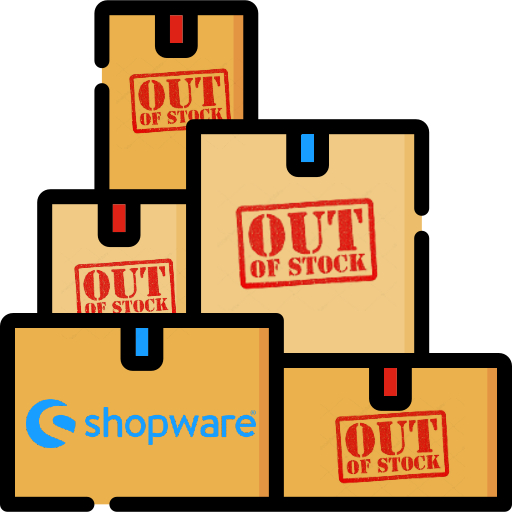
In the fast-paced e-commerce macrocosm, every product showcased on your online storefront is associated with multiple potential opportunities. So, in general, the more products you have – the more opportunities you face. But what if you run out of particular items? It often means that you reduce the number of potential benefits, facing new challenges instead. One of the challenges hidden among multiple e-commerce routines is out-of-stock product handling. While Shopware 6 offers an array of tools to streamline your business, one aspect often leaves merchants scratching their heads: the platform doesn’t provide the ability to deal with out-of-stock products effectively. For instance, the default setup doesn’t let you export zero-stock items to inform your wholesalers. Neither you can provide your potential buyers with pre-order options or back-in-stock information. But we know how to address these issues. The following article explores the risks associated with keeping out-of-stock products on your e-commerce website. You will also discover the vital strategies to help you navigate this domain successfully. We’ll uncover solutions that enable out-of-stock product export in Shopware 6 along with pre-orders and back-in-stock alerts. For further useful materials, visit our Shopware Cookbook.

Table of contents
- 1 Why Keeping Out-Of-Stock Products Is Dangerous
- 2 5 Simple Steps To Handle Out-of-Stock Products in Shopware 6
- 3 How to Always Keep Products In Stock With Shopware 6 Low-Stock Alerts
- 4 Final Words
Why Keeping Out-Of-Stock Products Is Dangerous
Let’s see why keeping out-of-stock products online is dangerous. There are a few aspects that you should always consider when it comes to an empty product stock:
- Customer Frustration: What can be more dangerous than a frustrated customer? Only multiple frustrated customers. When potential buyers visit your website and discover that the product they desire is out of stock, it can lead to disappointment. The more products are not available the more frustrated customers you get. This frustration diminishes the shopping experience and prompts your potential buyers to seek alternatives on competing websites. And bear in mind that disappointed customers may be less likely to return in the future.
- Reduced Credibility: Your online store’s credibility is paramount. And what do outdated or inaccurate product listings do? Right! They erode that credibility. Shoppers may question the reliability of your store if they frequently encounter out-of-stock items on your website. So, never let the zero-stock products affect their trust in your business.
- Wasted Marketing Efforts: Keeping out-of-stock products online can also result in weakened marketing efforts. Investing time and money in marketing campaigns, such as pay-per-click advertising or social media promotions, may be useless if these campaigns are aimed at out-of-stock products. Imagine a situation when your potential buyers click on ads only to find out that their desired products are unavailable. You lose opportunity and waste resources.
- Bad SEO Impact: It’s not a secret that search engine optimization is a key way to become visible online. Keeping out-of-stock products on your website may negatively impact your SEO ranking. Firstly, search engines may perceive your website as less relevant if it frequently displays unavailable items. Secondly, out-of-stock products reduce the average amount of time users spend viewing your store pages: if a potential buyer sees that their desired product is out of stock, they will quickly leave the page. The lower the average amount of time spent on your website is, the less attractive and interesting it is considered on the side of search engines.
- Missed Sales Opportunities: The most apparent risk is missed sales opportunities. When you have customers interested in products that are out of stock, you’re potentially losing your revenue. In the competitive e-commerce landscape, missing even a single sale can have a notable impact on your bottom line.
In light of these hazards, it is evident that every successful merchant should manage out-of-stock products properly. Therefore, let’s explore strategies for handling this challenge in Shopware 6.
5 Simple Steps To Handle Out-of-Stock Products in Shopware 6
Managing out-of-stock products in Shopware 6 can be simplified with a few user-friendly strategies. Here are a few practical approaches to keep your e-commerce store running smoothly without experiencing the negative impact of zero-stock items:
Export Out-Of-Stock Products from Shopware 6 & Contact Your Wholesaler
The very first thing to do about out-of-stock products is to contact your wholesaler and order a new batch of missing items. However, things get a little bit complicated when you want to do that, since Shopware 6 doesn’t let you export sero-stock items. You can clearly view them in a corresponding grid under Catalog -> Products after clicking on the In stock column a couple of times to place grid rows in the necessary order, displaying out-of-stock products first.
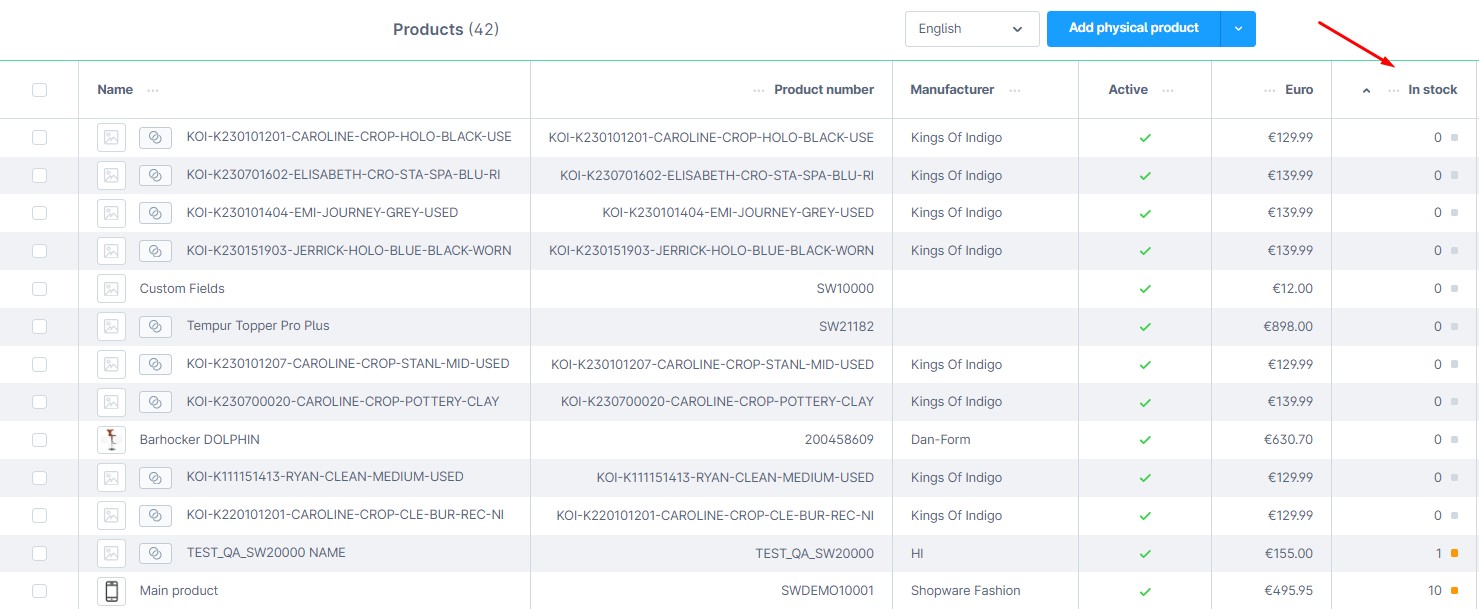
It’s not a problem if you have a few items no longer available. However, if you have dozens of them, copying them into a separate list manually is a complete waste of time. But you can use the Firebear Improved Import, Export & Mass Actions app to export the desired product smoothly.
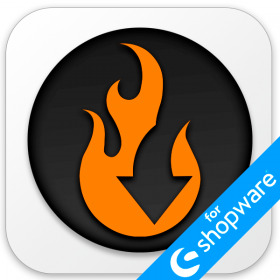
To export out-of-stock products from Shopware 6, follow these straightforward steps:
Step 1: Create a New Export Profile
Click the New Profile button, located under Extensions -> Improved Import, Export & Mass Actions -> Product Export to create a new export profile.

Step 2: Configure Export Settings
Now, you can start configuring your export profile to be able to transfer out-of-stock products from Shopware 6:
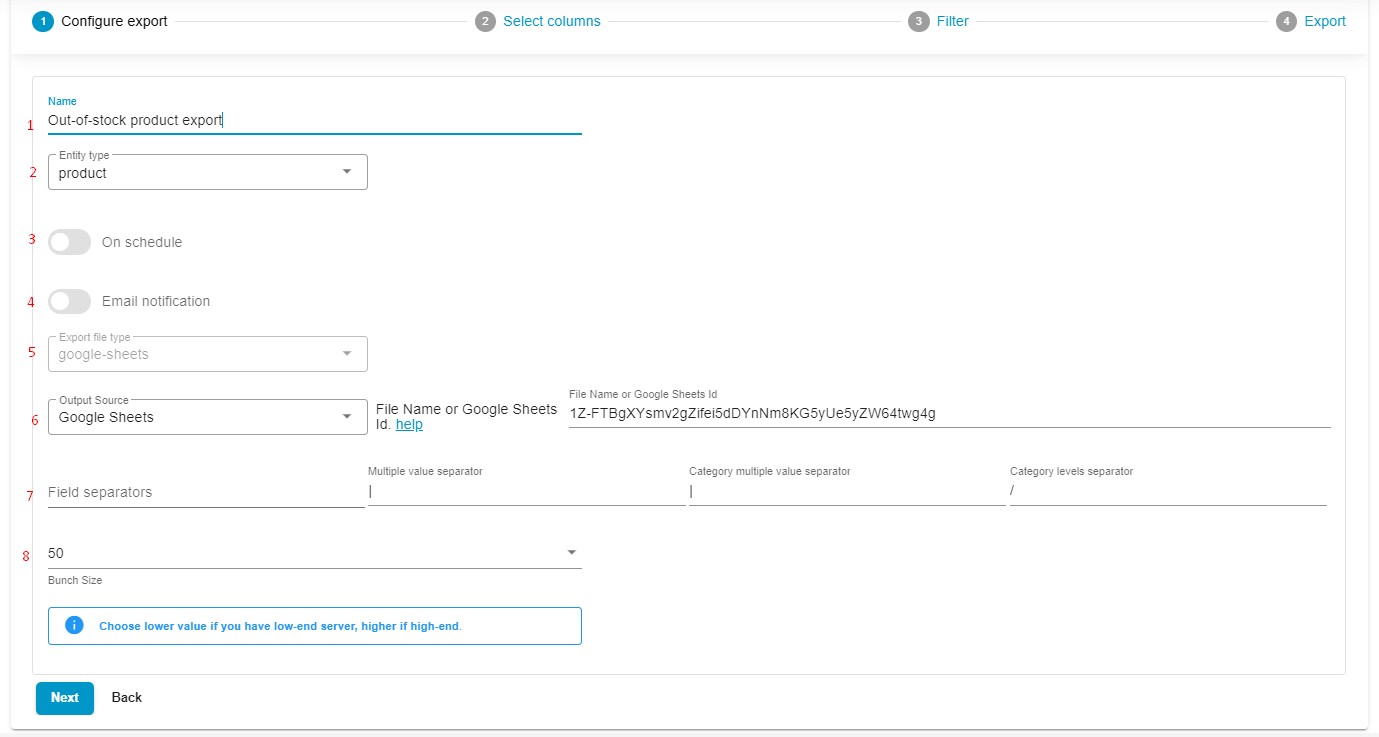
- Provide your export profile with a descriptive title – Out-Of-Stock Product Export.
- Choose the type of data you want to export – Products.
- If needed, establish a schedule for automated exports. We will explore a corresponding case below.
- Configure email notifications. You can stay informed about successful, failed, or both types of out-of-stock product exports. Or you can inform your wholesalers!
- Choose a file format suitable for your situation: XML, XLSX, or CSV. Alternatively, you can transfer out-of-stock products to a Google Sheets spreadsheet.
- Decide on your preferred export source: FTP, Google Drive, Google Sheets, or a simple file download.
- Specify separators.
- For optimal performance, especially on low-end servers, specify a bunch size with a lower value.
Step 3: Customize Columns
Click Continue to proceed to the Select columns screen. Here, you can reduce the size of your out-of-stock product grid: Uncheck any columns you prefer not to include in the export.
Also, you can customize the column titles to meet your partner’s specific requirements. Rename the default column titles by adding a new title (Rename) after the existing column name (Column). You can read more in our guide to Shopware 6 mapping.
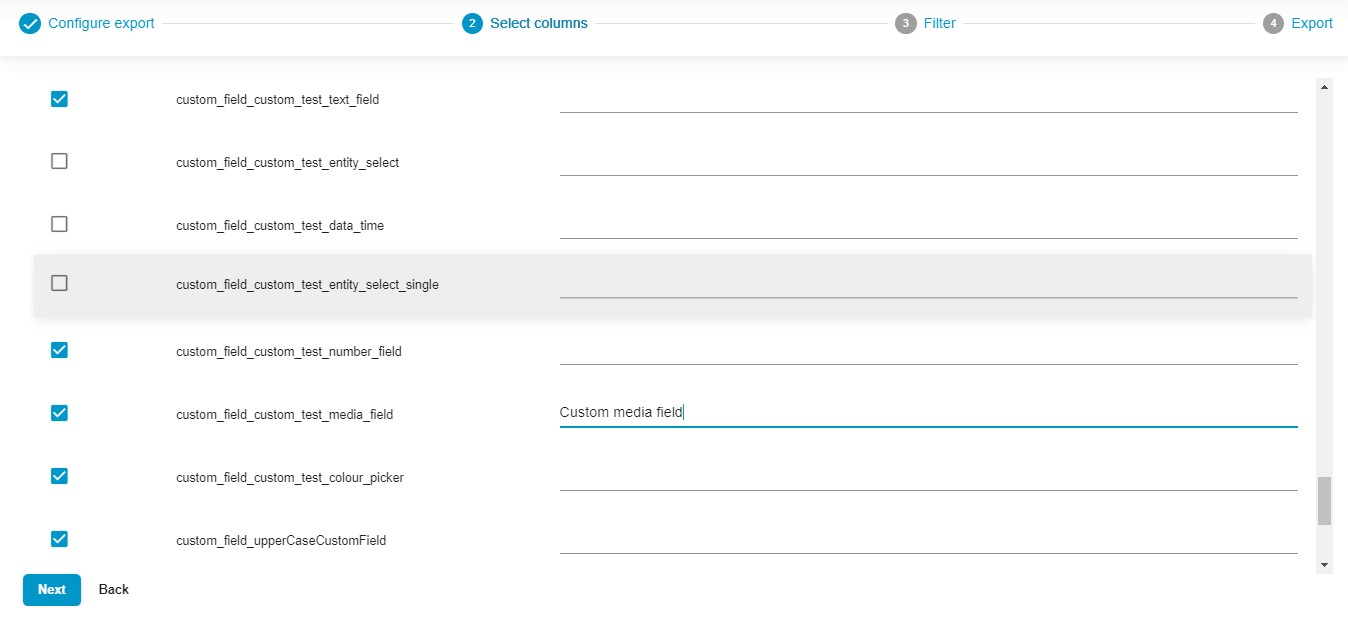
Step 4: Apply Filters
The third screen of your export profile empowers you to create filters. It is where you can focus on out-of-stock products solely:
- Press the “+” button;

- Select a product property – availableStock;
- Select an operator – Equals;
- Specify a value – 0.

That’s it! Your filter for Shopware 6 out-of-stock products is ready.
Step 5: Save and Export
Click the Save & Close button to store your Shopware 6 export profile or hit the Export button if you’re ready to proceed.

By following these user-friendly steps, you can export out-of-stock products from Shopware 6. For more in-depth information and detailed instructions, please refer to our How to Export Out-of-Stock Products from Shopware 6 guide or Firebear Improved Import, Export & Mass Actions Manual.
Step 6: Contact Your Partners
Now, you need to provide the information about zero-stock products to your wholesalers to order the necessary amount of the missing items. Following the flexible configurations of the Improved Import, Export & Mass Actions app, it is possible to export a file with the product titles you need straight to your partner via FTP, to a shared Google Sheet spreadsheet, or to a shared Google Drive folder. You can find corresponding guides here: Shopware 6 FTP Export Guide, Shopware 6 Google Drive Export Guide, and Shopware 6 Google Sheets Export Guide. You can also turn on email alerts to automatically inform your wholesaler about out-of-stock products if you order all items from a single partner. Refer to our Shopware 6 Guide to Export Email Notifications for more information.
Display Expected Restock Dates
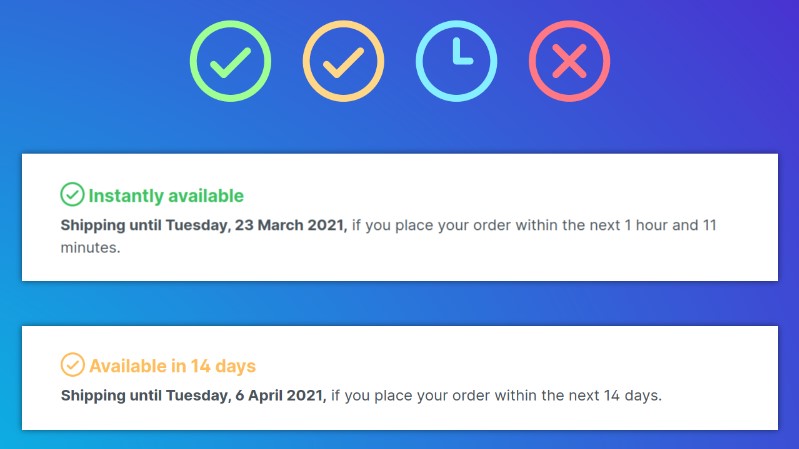
While you are waiting for products to be restocked, it is also a good idea to implement a couple more strategies to handle your out-of-stock products. First of all, consider displaying expected restock dates on product pages. This not only manages customer expectations but also encourages them to return to your store when the product becomes available again.
Since Shopware 6 doesn’t provide the corresponding functionality, you may consider using this . This tool provides the ability to display different messages on product availability. For instance, you can inform potential buyers that a product will be back in stock in, let’s say, 14 days on both product and category pages. Multiple color schemes are at your disposal. Also, the app supports estimated delivery date notifications.
Use Back-In-Stock Notifications
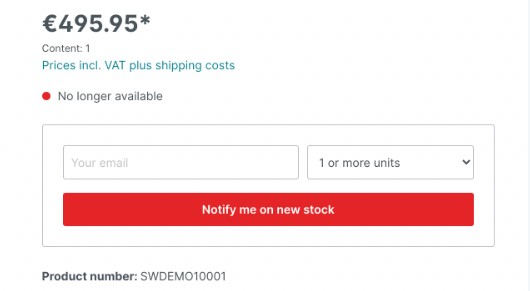
To enhance the effect of using the previous strategy, it is also worth implementing back-in-stock notifications. As you might have already guessed, Shopware 6 doesn’t have any such ace up the sleeve. However, you can easily implement the corresponding functionality with the help of this application. It adds an automated system to notify customers when out-of-stock products are back in stock. With this app, your customers can even decide how many products they want to be notified about. Another good thing is that the outgoing email notification directly includes the corresponding product link.
Offer Pre-Orders
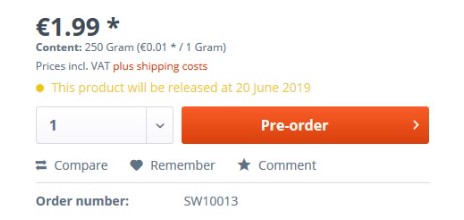
If you’re confident about restocking a popular product soon, offer pre-orders. Thus, you will reduce the impact of a zero-stock item to the bare minimum. However, you will need to use a third-party solution because Shopware 6 doesn’t allow you to set up pre-order options. For instance, this module enables customers to place orders for products that are not yet available in your store. Note that it is necessary to specify a product release date and enable the corresponding functionality in the backend to turn the Add to cart button into Pre-order.
Display Cross-Sells

You can use the out-of-stock situation as an opportunity to cross-sell or recommend alternative products to your buyers. Unlike the other strategies described above, cross-selling is available in Shopware 6 by default. You can enable cross-sells as follows:
Step 1: First of all, you need to log into your admin panel, navigating to Catalogues -> Products.
Step 2: Once you’ve found an out-of-stock product for which you’d like to add cross-sells, click on the Edit button.
Step 3: Now, you are on the Edit product screen. Navigate to its Cross-Selling tab.
Step 4: Here, you need to click on the Add new Cross-Selling button and fill in the following form to enable cross-sells for your out-of-stock products:
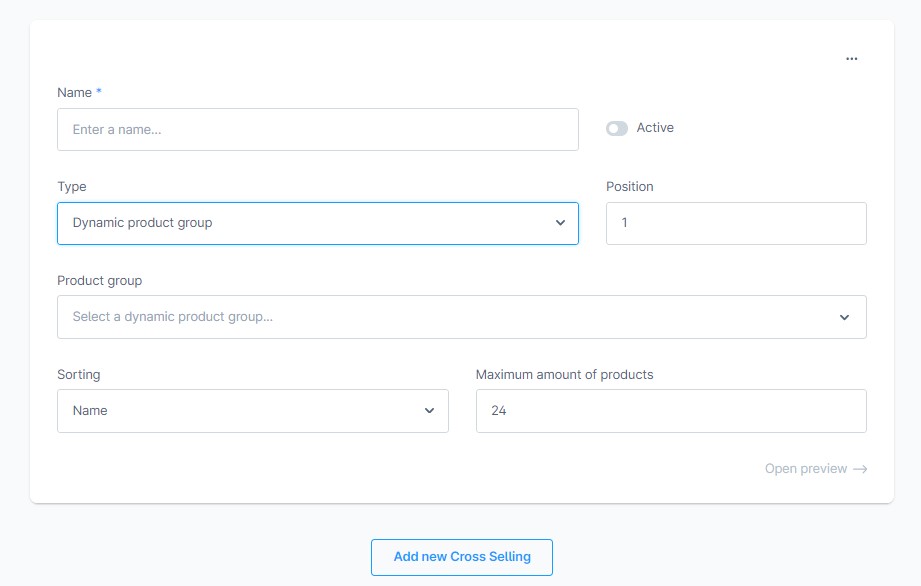
- Name your cross-selling item.
- Use the Active switch to enable or disable your cross-selling group.
- Choose either Dynamic Product Group or Manual Assignment. If you go with the latter, it’s necessary to select products manually.
- Set the position for your cross-selling section on the storefront.
- Next, you can select the appropriate product group to associate your cross-selling with if Dynamic Product Group is selected.
- Also, choose the sorting option for arranging the products in the cross-selling section.
- Since Shopify lets you specify the maximum number of cross-selling products to display, choose the quantity to align with your out-of-stock case.
- Use the preview option to see how the cross-sells look on your storefront.
- Add a new cross-selling group if necessary.
Step 5: Save your changes once the required information is provided.
How to Always Keep Products In Stock With Shopware 6 Low-Stock Alerts

Regular inventory updates are key to keeping products in stock. You need to regularly review your product listings and restock items with relatively small quantities. Depending on the kind of your products, these quantities may vary a lot.
For instance, you sell smartphones and your regular stock is 10 items. On average, you sell 5 items of each product per month. Then, you can create low-stock alerts when, let’s say, 4-5 items are left.
However, if you run an online grocery store, you may sell hundreds of items of each product daily. In this case, your low-stock alert should be bound to much higher numbers: 100, 200, 300, etc.
You’ve probably guessed already that Shopware 6 doesn’t let you create low-stock alerts. Therefore, it is necessary to rely on third-party, apps, such as .
With this application, you get the flexibility to customize notifications for both products and categories. As soon as your product’s stock falls below the designated minimum, you receive an email notification. Specify multiple recipients to ensure the right people are informed.
To get started, choose to monitor either All products or simply input the specific item number you’re interested in. What’s especially convenient here is the notification timeframe. You can receive notifications as soon as your inventory reaches the defined threshold. Alternatively, it is possible to schedule them, getting stock updates on an hourly, daily, or weekly basis.
Alternatively, you can use low-stock export alerts in Shopware 6. You will need to install the Firebear Improved Import, Export & Mass Actions app that we’ve already mentioned above. This time, you can use it to export products that reach a particular stock level and inform your partners about that.
- Step 1: Create a new export profile under Extensions -> Improved Import, Export & Mass Actions -> Product Export.
- Step 2: Configure export settings, such as a profile name, entity (we work with products), and others.
Create a schedule for automated exports to examine product stock frequently. For instance, you can create daily exports. Everything depends on the size of your stock, the amount of sales per day, and the time necessary to restock.
Configure email notifications to stay informed about products that run out of stock. You can send the corresponding notifications to your wholesalers. It’s a good idea to create a separate export profile for each supplier.
Next, choose a file format that the accepting side requires. Note that you can even transfer low-stock alerts to a Google Sheets spreadsheet. Other export sources include FTP transfers, Google Drive uploads, and simple file downloads. - Step 3: Customize columns. You can reduce the size of your product grid by unchecking any columns unnecessary for this kind of export. For instance, you can create an output file that includes the product title, ID, SKU, etc.
You can also customize the column names to meet your partner’s specific requirements. Rename the default column titles by adding a new title (Rename) after the existing column name (Column). - Step 4: Apply filters to your product export. Create a filter for the availableStock property but use the Range operator instead of Equals and specify a range from 0 to your threshold when you want to get a low-stock alert in Shopware 6, for instance, 10.

- Step 5: Click the Save & Close button to store your Shopware 6 export profile or hit the Export button if you’re ready to proceed.
You can find a more detailed guide in our Firebear Improved Import, Export & Mass Actions Manual.
By following these steps, you can create low-stock alerts for Shopware 6. It will help you reduce the amount of situations when you run out of a particular product. However, if your stock reaches zero, you already know what to do.
Final Words
Effective out-of-stock product management makes the difference between a successful online business and one that struggles to gain ground. As a flexible platform, Shopware 6 provides the tools you need to address the zero-stock challenges. Although the desired tools are not available by default, you can easily install them on your e-commerce website.
An understanding of the dangers associated with out-of-stock products can help you easily implement strategies to enhance the customer experience, boost your store’s credibility, and make the most of your e-commerce storefront. From well-elaborate communication with your business partners to proactive interaction with your buyers, Shopware 6 equips you with the means to keep your inventory full and your customers satisfied.

